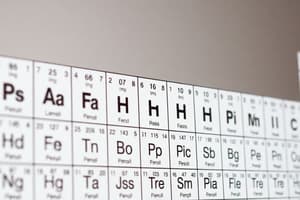Podcast
Questions and Answers
What is the main criterion used to organize elements in the periodic table?
What is the main criterion used to organize elements in the periodic table?
- Atomic weight
- Recurring chemical properties
- Oxidation states
- Number of valence electrons (correct)
Who was the Russian chemist who first proposed the periodic table in 1869?
Who was the Russian chemist who first proposed the periodic table in 1869?
- John Dalton
- Dmitri Mendeleev (correct)
- Johann Wolfgang Döbereiner
- John Newlands
Which group of elements in the periodic table has partially filled f orbitals?
Which group of elements in the periodic table has partially filled f orbitals?
- Alkaline earth metals
- Alkali metals
- Actinides and lanthanides (correct)
- Transition metals
What was unique about Mendeleev's arrangement of elements in the periodic table?
What was unique about Mendeleev's arrangement of elements in the periodic table?
Which group of elements exhibits variable oxidation states in the periodic table?
Which group of elements exhibits variable oxidation states in the periodic table?
What is the defining feature of alkaline earth metals in terms of valence electrons?
What is the defining feature of alkaline earth metals in terms of valence electrons?
Which of the following statements about elements in the same group of the periodic table is true?
Which of the following statements about elements in the same group of the periodic table is true?
What happens to the number of electrons as you move across a period (row) in the periodic table?
What happens to the number of electrons as you move across a period (row) in the periodic table?
Which of the following statements about the periodic table is incorrect?
Which of the following statements about the periodic table is incorrect?
What is the primary reason for the varied chemical properties of elements as you move across a period in the periodic table?
What is the primary reason for the varied chemical properties of elements as you move across a period in the periodic table?
Which of the following categories does the periodic table not include?
Which of the following categories does the periodic table not include?
What is the significance of the periodic table in the scientific community?
What is the significance of the periodic table in the scientific community?
Flashcards are hidden until you start studying
Study Notes
Understanding the Periodic Table
Overview
The periodic table is a tabular arrangement of all known chemical elements, organized according to their atomic number, electron configuration, and recurring chemical properties. It was first proposed by Russian chemist Dmitri Mendeleev in 1869 and has since become an essential tool for understanding the fundamental building blocks of matter and predicting the behavior of different substances.
Historical Context
Before Mendeleev's discovery, scientists such as John Dalton, Johann Wolfgang Döbereiner, John Newlands, and Alexandre-Emile Béguyer de Chancourtois had already identified patterns among the elements based on their atomic weight or other characteristics. However, it was Mendeleev who successfully arranged these elements into a comprehensive system that not only demonstrated a clear pattern but also predicted new elements yet to be discovered.
Structure and Organization
Elements in the periodic table are grouped together based on their shared properties. There are six main groups:
- Alkali metals, with one valence electron.
- Alkaline earth metals, with two valence electrons.
- Transition metals, which exhibit variable oxidation states.
- Post-transition metals, with two valence electrons.
- Nonmetals, including metals, metalloids, and nonmetal halogens.
- Lanthanides and actinides, a group of heavy elements with partially filled f orbitals.
Elements are also categorized into metals, hydrogen and its compounds, metalloids, and nonmetals.
Periodicity
As you move across a row (period) in the periodic table, the atomic number of elements increases, leading to differences in the number of electrons and, consequently, varied chemical properties. As you move down a column (group), elements have the same number of outermost electrons, resulting in similar chemical behavior.
Importance and Applications
The periodic table is an invaluable tool for chemists, physicists, and other scientists, as it provides a clear understanding of the relationships between different elements and their properties. It is used to predict the behavior of new elements, develop new materials, and understand the atomic structure of matter.
In summary, the periodic table is a vital resource in the field of chemistry that allows scientists to understand the fundamental building blocks of matter and predict their behavior. Its history and development are intertwined with the evolution of scientific understanding, and it continues to be a critical tool for advancing knowledge in the scientific community.
Studying That Suits You
Use AI to generate personalized quizzes and flashcards to suit your learning preferences.




